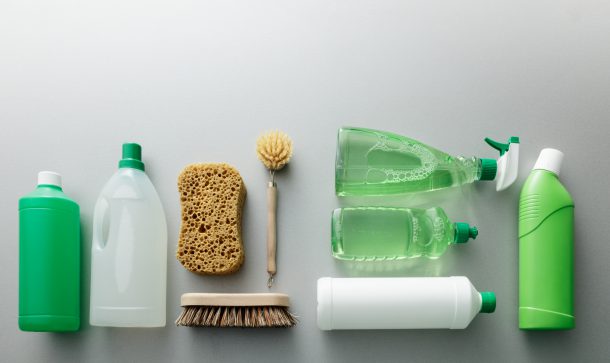

To determine whether a cleaning product is truly sustainable or not, you need to look at its entire lifecycle, writes GECA’s Kendall Benton-Collins.
While cleaning products are important for healthy and appealing living and working conditions, they can also have a negative impact on human health and the environment. For example, they may contribute to health problems such as skin irritation and asthma, and when discharged into waterways, long-lasting toxins can threaten water quality and wildlife.
To determine whether a cleaning product is truly sustainable or not, you need to look at its entire lifecycle. That means from the sourcing of raw materials and the manufacturing process, to use and finally its ultimate disposal. Here are some of the key things to look for when you’re on the hunt for environmentally-preferable cleaning products.
Human health: hazardous substances and air quality
Most of us don’t know a great deal about the chemicals present in cleaning products – we simply trust that they will do the job and leave surfaces fresher, cleaner and healthier, with an indoor environment free from germs and dirt.
Unfortunately, a lot of cleaning products can contain a range of potentially harmful materials. For example, there’s a vast array of chemicals which bear ‘Risk Phrases’ to declare that a substance may be a carcinogen or harmful to a developing foetus.
Volatile organic compounds (VOCs) are also present in many products. These contribute to poor indoor air quality, lingering in the air all day after the solvents used in cleaning solutions evaporate.
They can trigger allergic reactions, headaches, eye irritation, and asthma problems, affecting cleaning staff and building occupants alike. While it is legal to use products that emit VOCs, many facilities management professionals are becoming increasingly aware of the problems caused by these emissions.
Anything from the paint on the walls to the choice of flooring and upholstery materials can cause the building’s air quality to suffer, but cleaning products are one of the simplest things to change. The addition of certain fragrances may also trigger allergic reactions, asthma, headaches and respiratory irritation.
Even though it may not be top of mind for most of us when considering green cleaning products, a truly sustainable product must also be made under safe working conditions, where fair and equal opportunities are available to workers.
Environment: palm oil, water quality and packaging
From an environmental perspective, an important factor to consider is whether a cleaning product contains palm oil or palm kernel oil. If it foams and suds, there’s a good chance it does.
The oil has many desirable qualities, such as having a stable shelf life and making cleaning products creamier. However, the production of palm oil can cause significant deforestation when it’s harvested unsustainably, wreaking havoc on the environment, devastating orangutan populations and other vulnerable species, and displacing local communities.
The environmentally hazardous substances aren’t just limited to palm oil. The discharge of nutrients such as phosphorous compounds, present either in the manufacturing process or in the cleaning products themselves, can cause algal blooms when they end up in waterways. Other long-lasting substances can be toxic to aquatic life in surface waters and streams.
Finally, there’s the product packaging, which should ideally be as efficient and recyclable as possible at all stages across the product’s life cycle. Inefficient use of packaging can result in greater transportation needs, natural resource depletion and increased burden on landfills.

Don’t forget fitness for purpose
Of course, on top of all these essential environmental and health criteria, the product must also be fit for purpose. That is, it must do what it claims to do on the packaging. There’s no use having a cleaning product crafted from the finest ingredients if it doesn’t deliver on its promise to give you a great clean!
Ecolabels take the guesswork out of sustainable purchasing
If you’re looking for products that will deliver that sparkling clean while also being kind to people and planet, independent certification removes doubt and confusion and makes identifying environmentally and socially preferable products easier.
Key qualities to look for in an ecolabel are:
- independence;
- transparency and consistency in its standards; and
- third party accreditation and verification processes (where the verification and licensing agencies are also independent of one another).
Robustness, credibility and impartiality are what build the reputations of good ecolabels so that suppliers and consumers can come to trust them. When a product is certified against Good Environmental Choice Australia (GECA)’s Cleaning Products standard, consumers can be sure that the product has been assessed to meet environmental, human health and ethical impact criteria.
Products certified under GECA’s Cleaning Products standard also contribute towards achieving credit points for projects being certified under the Green Building Council of Australia’s Green Star Performance tool.
*Kendall Benton-Collins is digital marketing officer at GECA
This first appeared in the September/October issue of INCLEAN magazine.